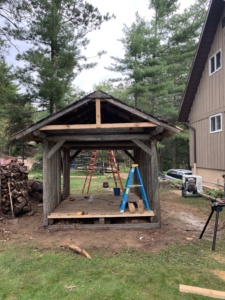Working With Others Can Be Painful. It Shouldn’t Be!
Teaming and collaboration experiences happen in all walks of our professional and personal lives. Some experiences working with others are draining, others passable, and just a few are energizing and even fun.
Whether you’re working to bring a new product or program to life or, as was my case over the weekend, rebuild a cool log shed at the lake house, we’re all looking to create extraordinary experiences that both achieve our objectives and exhilarate our spirits.
Rebuilding the Logshed in the Northwoods
 For three non-carpenters working on this log shed project, the process was one of trying different ideas, laughing at our mistakes, and challenging ourselves to think differently about how we might bring this unique structure back to level and life. After a twelve-hour day that involved ratchet straps, a car jack, a come-along attached to a truck, and much sawing, hammering, and replacing old, squirrel-eaten cedar, one of the individuals offered, “This is the way it should be.” He was referencing the fun we had working together and creating a pretty good outcome.
For three non-carpenters working on this log shed project, the process was one of trying different ideas, laughing at our mistakes, and challenging ourselves to think differently about how we might bring this unique structure back to level and life. After a twelve-hour day that involved ratchet straps, a car jack, a come-along attached to a truck, and much sawing, hammering, and replacing old, squirrel-eaten cedar, one of the individuals offered, “This is the way it should be.” He was referencing the fun we had working together and creating a pretty good outcome.
Be Deliberate About Creating Your Team and Teaming Environment
I agree. We all spend a lot of time doing things we would never describe as fun in our working lives. Life is too short, and the time in our careers is too valuable to miss out on great collaboration experiences. You can hope these fun, productive experiences emerge by chance. Or you can be deliberate about creating the conditions that improve the possibility of a great collaboration experience. I opt for improving our odds of bringing one of these productive, fun experiences to life.
Four Big Ideas to Have More Fun While Collaborating Successfully With Others at Work
1. Let People Who Care Opt-In To Your Initiative
If all the collaborators aren’t jazzed by the challenge and the potential to fix, create, or save something, it’s just more work on top of mountains of stuff in everyone’s daily lives. Take time ahead of initiatives to talk about what the outcome will be. Who will benefit? Why will a good result be important to them? And then, do something courageous and ask individuals to opt in or decline. And thank them for their honest choice.
For the log shed project, each of us appreciated the skill it took to hand build this structure several decades ago. It held well until time and nature wore down some structural supports. The extreme list to the left and downhill the long way made this a candidate for the chain-saw. Yet, we all appreciated the hand-shaven cedar timbers and the notched Lincoln Log construction by the original builder. We agreed that properly restoring would be both practical and offer a nice aesthetic on the property. After discussing the merits of knocking down the structure or doing the unfamiliar work to attempt to fix it, we opted for the save.
2. Harness Different Experience Levels and Unique Points-of-View
The three of us working on the log shed project had such different cultural, work-life, and experience differences it was almost comical to think about it. We called out these differences and had a good laugh wondering how this collaboration would work and how three, unlike characters, could get along well enough to be successful. Once we got to work, we singled out our different viewpoints as our greatest strength, considering none of us knew how to do the complete job.
One of the professionals I admire a great deal is a master team builder. She brings teams to life, and they accomplish remarkable things using data and technology. When I asked her what her secret was, her answer spoke volumes (I paraphrase): “I put people together who look at each other and have no idea why they’re on the same project or in the same room together. And then I free them to work their magic.”
There’s no magic involved when you harness very different individuals’ unique insights, experiences, and perspectives. It’s an essential ingredient for high performance.
3. For Novel Problems—Their Ideas Are Everything
We should all worry about the great ideas in our workplaces that are never shared by individuals who fear being judged by others. Team and collaboration success rises or falls on the ability of individuals to look at novel problems and identify ideas and experiments to solve them. Make sure your environment is healthy enough for your team members to offer: “What if…?” suggestions.
While an experienced carpenter would likely have had suggestions for us for leveling our log shed, it took some creative experimenting to deal with our constraints and identify different ways to use physics and leverage to solve the multi-direction leaning challenge. It turns out there was no one solution—it took five unique ideas to solve the problems ultimately and leave the shed (mostly) level and solid.
4. Laugh—a lot.
In my best career teaming experiences, laughter was a common ingredient. People were comfortable laughing at themselves, the situations, and the many things that invariably didn’t comply with our plans. The comfort of laughing connects directly to people’s comfort in sharing what they view as wild ideas. Laughing together builds camaraderie and supports the emergence of trust. And when the time for being serious is there, the bond is more substantial for teams who take their initiative but not themselves too seriously.
I had more fun working with the crew on this log shed project than I’ve had in a long time. The outcome isn’t master carpenter perfect, but we weren’t chasing perfection. We were after mostly level, structurally stable, and functional. Next, I need to work on the aesthetics of the shed. I have the roof and the staining to come. I know there are a few more laughs ahead.
The Bottom Line for Now:
Fun. Productive. Creative. Successful. That’s the way it should be.
![]()

